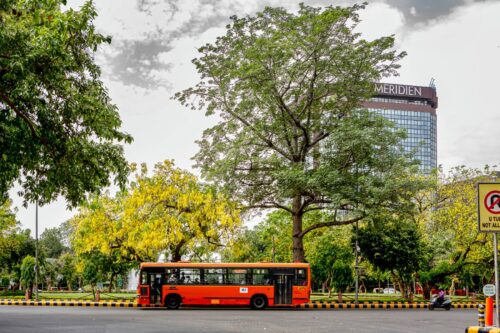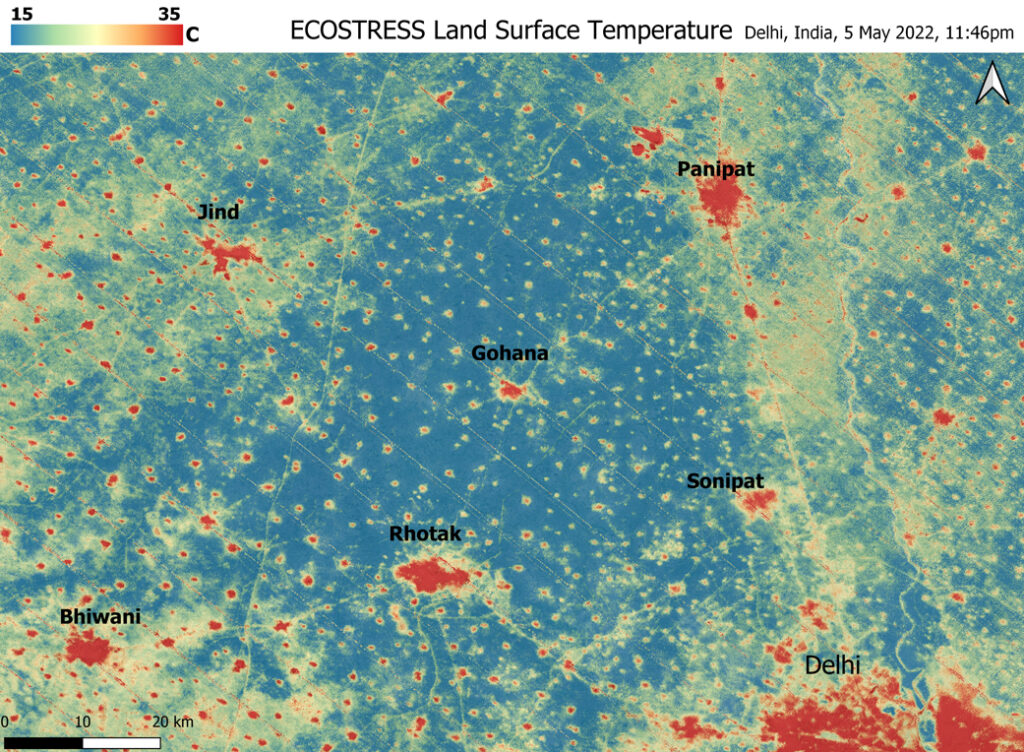
Tackling Extreme Heat through Urban Forestry in Delhi
The case for a more thoughtful approach to the city’s trees
This article was coauthored by Raghav Anand of RMI India.
Temperatures in Delhi breached 49°C (120°F) on May 15th, the hottest ever recorded in the city. Beyond its immediate effects on public health, such extreme heat negatively impacts income equality, productivity, and even sleep — especially in cities like Delhi where heat and heat risks are at their highest.
Cities are often 2°C to 9°C (3.6°F–16.2°F) hotter than surrounding peri-urban and rural areas because their densely concentrated roads and buildings absorb and store solar radiation. Additional heat is generated locally from electricity generation, air conditioning, motor vehicles, and industrial activities. These conditions result in the urban heat island effect. During Delhi’s May heatwave, night-time temperatures in built-up areas were 20 °C (36°F) hotter than surrounding agricultural and forest lands. Cooler nighttime temperatures are critical to allowing the body to recover from daytime heat exposure — especially for the majority of Indians without access to air conditioning.

The urban heat island effect around Delhi in May as visualized by NASA’s ECOSTRESS model. Credit: NASA/JPL-Caltech
Delhi — projected by the United Nations to be the largest global urban agglomeration by 2030 — has been ranked the second most heat-stressed city in the world. Around 2 million of its residents live in slums or informal settlement colonies, where homes are often ill-equipped to protect inhabitants from extreme heat. Authorities must, therefore, move beyond “emergency plans so that the death toll is not high” during heatwaves and start looking toward long-term fixes. Fortunately, Delhi is well placed to take advantage of a powerful and cost-effective solution: nature.
Forests, parks, gardens, and bodies of water can be important tools in a city’s heat resilience toolkit, and Delhi’s wealth of green space puts it in a good position to take advantage of nature’s cooling potential. Delhi hosts 18,000 parks covering almost 20,000 acres, green cover over the alluvial deposits in the Yamuna floodplain, and over 8.5 square kilometers of mixed forests on the Central Ridge. Green cover reduces “felt” (physiologically equivalent) temperatures by 5–14 percent, and urban bodies of water can lower local temperatures by up to 8°C. Trees are particularly powerful and can cool their surroundings with the equivalent power of a 7 kilowatt air conditioner by providing shade and cooling the air through evapotranspiration.
While there is significant opportunity for cooling through urban trees, many of Delhi’s forests, parks, and gardens are currently deforested and therefore do not provide the benefits they ideally could. Reforesting low-density forests (which make up approximately 70 percent of Delhi’s forest cover) and greening neighborhood parks and streets could be a major step toward long-term heat mitigation.
Unlocking this potential will require that the city plans its greenspaces while maintaining focus on the distinct ecological needs of specific ecosystems. Delhi’s diverse geography and ecosystems mean that species that thrive in the Yamuna floodplain won’t survive on the Ridge — or will require prolonged intervention to do so. Worse, poor species selection can threaten the existence of other species in the area, in addition to impacting groundwater supply and biodiversity more broadly. For example, the infamous exotic (i.e., non-native) species Prosopis juliflora (or vilayati kikar) and Lantana camara have aggressively spread across the state to now be Delhi’s most abundant tree and shrub species respectively.
Instead, tree-planting and landscaping need to take into account each site’s soil, terrain, hydrology, and microclimate, with locally adapted native species being prioritized accordingly. Doing so can mitigate local heat islands while simultaneously maximizing long-term survival in a resource-efficient manner. Delonix regia (Gulmohar), for instance, reduces local heat stress significantly but cannot thrive in water-scarce terrain, where certain shrubs that may produce slightly less pronounced heat resilience effects are better suited for survival. Renowned naturalist Pradip Krishen states that with appropriate selection and management, Delhi’s Central Ridge can “support 80 species of trees and large shrubs” (up from the 10–12 seen today).
Aligned with these suggestions, and inspired by the success of Gurgaon’s Aravalli Biodiversity Park, here are five recommend practices to maximize the ecosystem health — and therefore heat mitigation potential — of Delhi’s green spaces.
- Create a standardized and scientific species selection framework for Delhi’s various micro-habitats to ensure a healthy combination of native species suited to each site’s soil, terrain, hydrology, and microclimate. Sadly, Delhi’s forests are filled with species unsuited to their sites. An investigation of Delhi’s Taj Enclave urban forest revealed widespread plantation of non-native species.
- Model planting patterns on relatively undisturbed, healthy forest ecosystems that resemble Delhi’s (e.g., avoiding manicured rows of pit trenches, and sequencing planting so hardier species can protect more weather-sensitive ones).
- Develop and adhere to a set of best practices for planting and management that ensure soil and tree root health and quickly wean trees off irrigation (the right species, managed the right way, will not need the dams and artificial water bodies being planned on the Central Ridge).
- Use biological (not chemical) methods to control and remove invasive species.
- Ensure tree and plant nurseries have a sufficient supply of locally adapted native species to meet the demand for tree plantation in Delhi’s different ecosystems.
Within these recommendations, equity considerations need to be front and center. Poorer households in Delhi are more likely to be situated in dense urban areas that face greater heat stress — thanks in large part to the absence of green cover. While some of these less-affluent neighborhoods may not have the space for local parks and forests, they can benefit greatly from linear plantations along roads, or even scattered individual trees.
Tapping into the true potential of healthy urban forests as an effective protection against urban heat should remain a focal point for Delhi’s environmental ambitions. Not only do healthy urban forests and trees increase urban heat resilience, they also directly address many of the city’s most pressing issues by reducing air and noise pollution, enhancing water security and mitigating flooding, helping create additional livelihoods, and bringing significant health benefits. Best practices like systems-level analysis, site-specific planning and maintenance, and community input are pre-requisites to ensure Delhi’s forests and parks produce equitable and long-lasting positive outcomes. Systematically addressing Delhi’s extreme heat islands will require a range of actions across the built environment, and urban nature offers some of our most powerful and equitable long-term solutions.